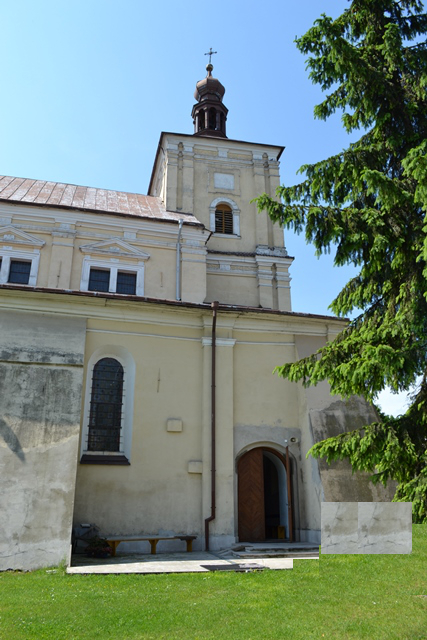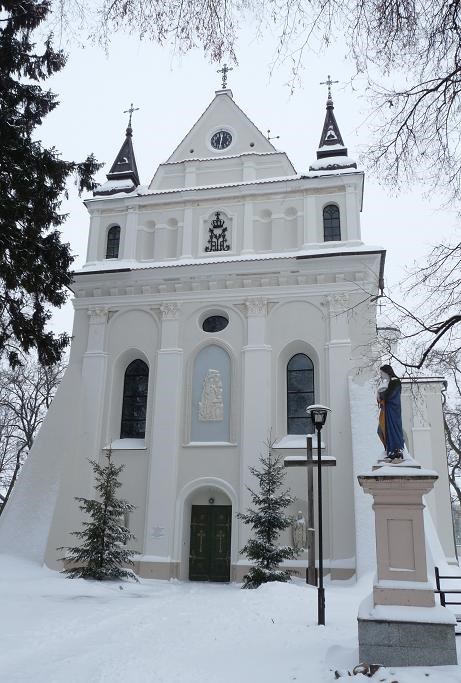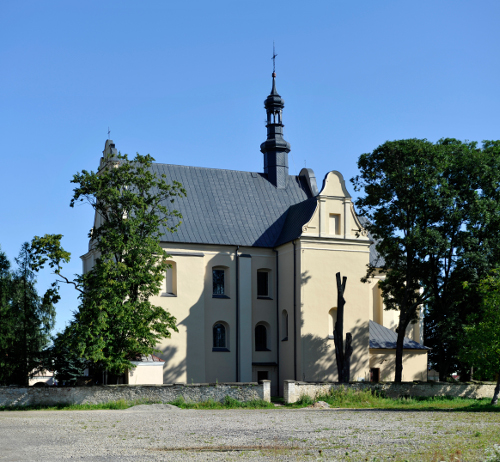Szlak Renesansu Lubelskiego

This parish church was built in the first half of the 17th century on the site of the original wooden church. It was founded by the Głuski family, the owners of Wilków from the 16th to the mid-18th century. The building partially burnt down in 1723 and was rebuilt in the second half of the 18th century and in the early 19th century. It acquired its present look after restoration work carried out in the second half of the 19th century. ...

The church gained its present shape in the second half of the XVI century. In 1563 the building was converted into an Arian church and it was not until 1610 that it became a Roman Catholic temple again. The church was rebuilt in the beginning of the XVII century in the style of the Lublin Renaissance, probably under instructions of the guild mason Jan Wolff. The new vault has stucco decorations forming a network of torus mouldings. The church has one nave and a narrower chancel terminated in a semicircular apse. There is a vestry with a vestibule adjacent to the chancel and a tower with a chur ...

The St. John Baptist's parish church was erected in the years 1648-53. It bears the features typical of the Lublin Renaissance. The church was endowed by Jan Zamoyski. The former temple was wooden and most probably dated back to the 14th century. ...

Before it was turned into a convent, the building in Świętoduska Street was a Renaissance fortified manor owned by the voivod Rafał Leszczyński, who intended to give it to the Lublin calvinist community. It was built in the years 1619-1622 by Jakub Balin and, after the calvinists left the city, it was bought by the Carmelite Sisters. The adaptation of the building lasted from 1630 to 1635. When the convent was completed, the construction of the temple began (1636-1640). ...

The present-day church was built in place of the former Holy Trinity Church in the years 1620-1638 and endowed by Tomasz Zamoyski and his wife Katarzyna Ostroróg Zamoyska. The building was erected together with a brick monastery meant to house the The Franciscan Order. In 1812 it was transformed into a hospital, and at the end of the 19th century the church was overtaken by the Russian authorities and transformed into an Orthodox church. In 1917 it was given back to the Catholics and obtained the name of St. Catherine. ...

The church was built in the years 1618–1631 with a contribution from the known architect Jan Wolff. It was founded by Adam Noskowski, Lublin chamberlain and owner of Łęczna. The building is characteristic of the Lublin Renaissance. It has one nave with a narrower chancel ending in a semicircular apse. Two adjoining chapels are symmetrically based on a square plan. Each has a dome with a roof lantern decorated with stuccos, fragments of which have survived till present day. The triangular gable with two side pinnacles was added when the church was rebuilt. ...

Legend has it that the first temple here was founded by Mieszko I in 986. The present church was built in the first half of the 16th c. on an escarpment towering over the Czechówka river valley. Owing to the rector of the parish, priest W. Turobojski, it was rebuilt in the Lublin Renaissance style in the first half of the 17th c. ...

The present-day parish St. Nicholas Church was erected in the years 1610-1620 in the place where the former wooden temple used to stand. The initiator of the construction works was the priest Nicholas Kiślicki – the dean of the Chapter of the Collegiate Church in Zamość. After the fires in the years 1668-1754 the building was rebuilt. It obtained its present architectural shape after the general refurbishment at the end of the 19th century. ...

The parish church was erected at the beginning of the XVII century and was designed by Piotr Durie – an architect of Italian descent, who lived in Lublin. The ceremonious consecration of the church took place on the 1st of October 1617 and was conducted by the benefactor of the church, i.e. by the bishop of the Płock diocese, Henryk Firlej. ...

The parish church in Modliborzyce was erected in the years 1645-1664, on the initiative of the standard-bearer of Bełżec and the local landowner, Stanisław Wioteski. The parish was transferred form the nearby village of Słupie. The church was consecrated in 1668 and the parish was entrusted to the protection of St. Stanislaus Bishop and Martyr. ...
Page 3 of 5













